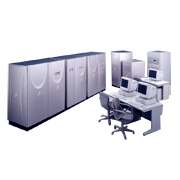Fujitsu announced a new high-end model group for its GS8000 (global server) series in January 1998. This was the first time standard CMOS processors were used in ultra-large Fujitsu mainframe computers. On a single CPU basis, the GS8800 models outperformed the previous ultra-large GS8600 models by 1.8 times, and the flagship 12-CPU model outperformed its counterpart by about 2.3 times. With the addition of the GS8800 model group, the GS8000 series covered a 3,400-fold performance range.
Features of the GS8800 model group:
- (1)Employed the latest CMOS*1 technology (0.25 micron process)
- On a single CPU basis, CMOS technology achieved about 1.5 times the performance of the M-1900, Fujitsu’s top model with ECL*2 technology.
- (2)Achieved 12-CPU TCMP*3 with advanced high-density mounting technologies such as MCM*4 and system boards.
- (3)Greater scalability with paralleling SCMP*5 technology
- With models expandable up to eight-node clusters, this model group covered a 23-fold performance range.
- (4)Models needed only a third of the previous models’ installation space, and the new OCLINK*6 station (F9160B) was expandable to as many as 240 connection ports.
- *1. CMOS: Complementary metal oxide semiconductor.
- *2. ECL: Emitter coupled logic.
- *3. TCMP: Tightly coupled multiprocessing
- *4. MCM: Multichip module. A module that mounts multiple LSI chips on a thin-film ceramic substrate.
- *5. SCMP: SSU-Coupled Multiprocessors. SSU: System storage unit.
A parallel-processing methodology first provided with the M-1800 model group (1990). - *6. OCLINK: Optical channel link.
Fujitsu’s own storage-connection interface standard for high-speed data transfers between global servers and storage units. The standard’s maximum transfer speed was 17 MB/s.
Fujitsu announced the even more advanced GS8900 model group, consisting of 12 models, in October 1999. The GS8900 group featured 0.18-micron CMOS technology, faster single CPU performance (about 1.5 times better than existing models), and scalability up to 16 CPUs in a TCMP configuration. Performance exceeded 2,000 MIPS in the 16-CPU configuration.
| Model name | 10A | 20AS | 20A | 30A | 40A | 40B | 60B | 80B | 100B | 120B | 120T |
|---|---|---|---|---|---|---|---|---|---|---|---|
| Introduced | May 1998 | January 1998 | February 1999 | ||||||||
| Relative performance*1 | 3.0 | 4.2 | 5.4 | 7.7 | 9.8 | 14.8 | 20.3 | 25.6 | 30.2 | 34.0 | 38.9 |
| No. of CPUs | 1 | 2 | 3 | 4 | 6 | 8 | 10 | 12 | |||
| Main memory capacity | 512MB - 8GB |
1GB - 8GB |
1GB - 16GB |
||||||||
| System memory capacity | 5124MB - 16GB | ||||||||||
| Channels | 16 - 256 | ||||||||||
| Model name | 10P | 10Q | 10R | 10S | 10 | 20S | 20 | 60A | 80A | 100A | 120A |
|---|---|---|---|---|---|---|---|---|---|---|---|
| Introduced | *2 | May 1998 | January 1998 | ||||||||
| Relative performance*1 | 1 | 1.3 | 1.7 | 2.3 | 3.0 | 4.2 | 5.4 | 13.5 | 17.2 | 19.9 | 22.4 |
| No. of CPUs | 1 | 2 | 6 | 8 | 10 | 12 | |||||
| Main memory capacity | 256MB - 4GB |
256MB - 8GB |
512MB - 8GB |
1GB - 16GB |
|||||||
| System memory capacity | 5124MB - 16GB | 5124MB - 16GB | |||||||||
| Channels | 16 - 128 | 16 - 256 | |||||||||
*1. Taking the performance of the GS8800/10P as the baseline.
*2. This model was not announced in May 1998 but went on sale in October 1998. Models 60A through 120A (shaded area above) were replaced by models 60B through 120B in February 1999.
| Model name | 200 | 300 | 400 | 500 | 600 | 700 | 800 |
|---|---|---|---|---|---|---|---|
| Introduced | January 1998 | ||||||
| No. of clusters | 2 | 3 | 4 | 5 | 6 | 7 | 8 |
| No. of CPUs | 1 - 12/cluster | ||||||
| System memory capacity | 512MB - 16GB (dual redundancy and quad redundancy optional) | ||||||
| Cluster connection units | 2 (redundant architecture standard) |
||||||
| Model name | 900 | 1000 | 1100 | 1200 | 1300 | 1400 | 1500 | 1600 |
|---|---|---|---|---|---|---|---|---|
| Introduced | February 1999 | |||||||
| No. of clusters | 9 | 10 | 11 | 12 | 13 | 14 | 15 | 16 |
| No. of CPUs | 1 - 12/cluster | |||||||
| System memory capacity | 512MB - 16GB(dual redundancy and quad redundancy optional) | |||||||
| Cluster connection units | 2 (redundant architecture standard) | |||||||
The specifications above were correct at the time the products were announced. Some specifications were later revised due to product upgrades.


